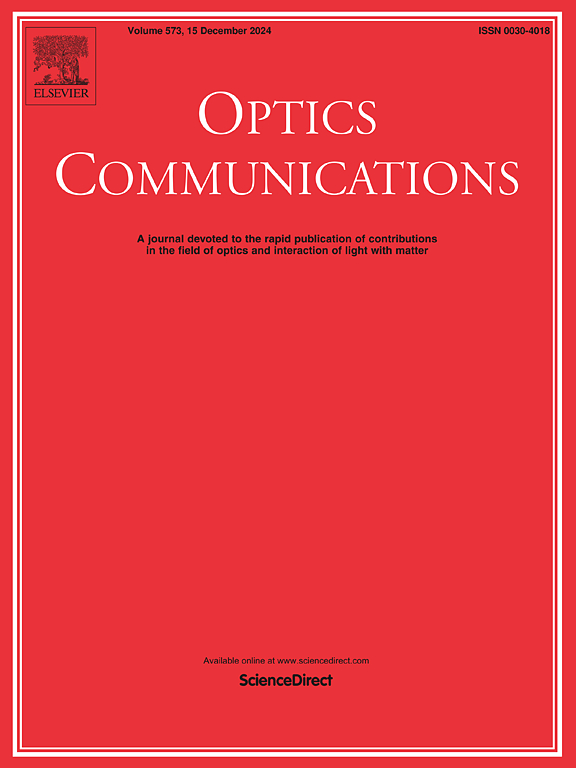基于级联双平行马赫-曾德尔调制器的多普勒频移和到达角同时无二义测量的光子方法
IF 2.5
3区 物理与天体物理
Q2 OPTICS
引用次数: 0
摘要
提出了一种利用级联双平行马赫-曾德尔调制器(DPMZM)结构测量多普勒频移(DFS)和到达角(AOA)的单通道光子方案,并进行了实验验证。该方案具有同时和明确测量DFS和AOA的特点。所传送的信号和低频参考信号被馈送到第一调制器(DPMZM-1)以调制所述光载波。DPMZM-1工作在载波抑制单边带(CS-SSB)模式下,产生两个+1阶光边带。然后将两个边带信号发射到第二个调制器(DPMZM-2)并由回波信号调制。DPMZM-2的主调制器和两个副调制器分别在最大值和正交点工作。光电探测器将DPMZM-2输出的光信号转换成下变频的低频(DCLF)信号。DFS是通过比较DCLF信号与参考信号的频率而得到的。AOA的值可以通过AOA-to-power映射得到。实验结果表明,在4-18 GHz带宽范围内,DFS测量误差保持在±0.1 Hz以内。杂散抑制比超过36db。在- 62.7°~ 62.7°范围内,AOA误差小于±1.4°。本文章由计算机程序翻译,如有差异,请以英文原文为准。
Photonic approach for simultaneous and unambiguous measurement of Doppler-frequency-shift and angle-of-arrival based on cascaded dual-parallel Mach-Zehnder modulators
A single-channel photonic scheme using cascaded dual-parallel Mach-Zehnder modulator (DPMZM) architecture for measuring Doppler frequency shift (DFS) and angle of arrival (AOA) is presented and experimentally demonstrated. The scheme features simultaneous and unambiguous measurements of DFS and AOA. The transmitted and a low-frequency reference signals are fed into the first modulator (DPMZM-1) to modulate the optical carrier. The DPMZM-1 operating in carrier suppressed single sideband (CS-SSB) mode generates two +1-order optical sidebands. The two sideband signals are then launched into the second modulator (DPMZM-2) and modulated by the echo signal. The main modulator and two sub-modulators of the DPMZM-2 operate at the maximum and quadrature points, respectively. The photodetector converts the optical signal output from DPMZM-2 into a down-converted low-frequency (DCLF) signal. The DFS is derived by comparing the frequency of the DCLF signal with that of the reference signal. The value of AOA can be obtained based on AOA-to-power mapping. Experimentally, the error in DFS measurement is maintained within ±0.1 Hz over a bandwidth of 4–18 GHz. The spurious suppression ratio exceeds 36 dB. The AOA error is less than ±1.4° from −62.7° to 62.7°.
求助全文
通过发布文献求助,成功后即可免费获取论文全文。
去求助
来源期刊

Optics Communications
物理-光学
CiteScore
5.10
自引率
8.30%
发文量
681
审稿时长
38 days
期刊介绍:
Optics Communications invites original and timely contributions containing new results in various fields of optics and photonics. The journal considers theoretical and experimental research in areas ranging from the fundamental properties of light to technological applications. Topics covered include classical and quantum optics, optical physics and light-matter interactions, lasers, imaging, guided-wave optics and optical information processing. Manuscripts should offer clear evidence of novelty and significance. Papers concentrating on mathematical and computational issues, with limited connection to optics, are not suitable for publication in the Journal. Similarly, small technical advances, or papers concerned only with engineering applications or issues of materials science fall outside the journal scope.
 求助内容:
求助内容: 应助结果提醒方式:
应助结果提醒方式:


